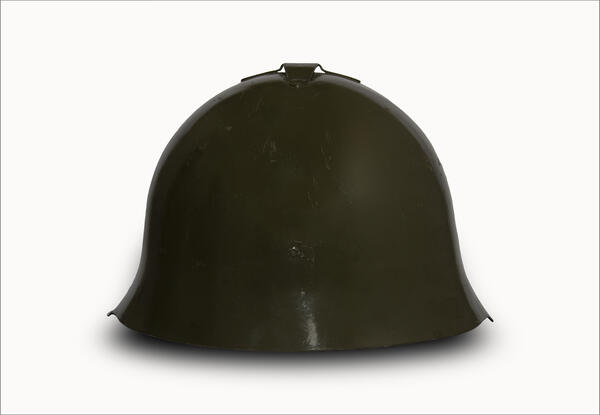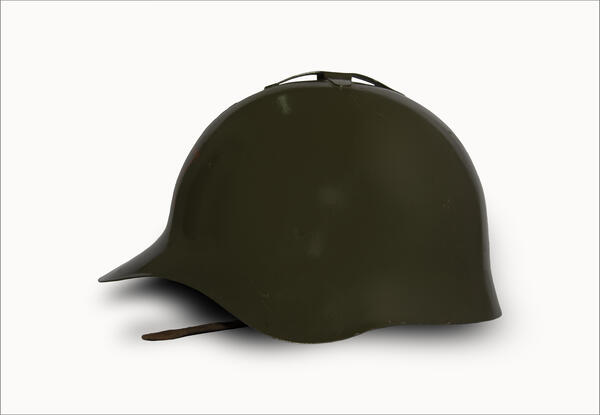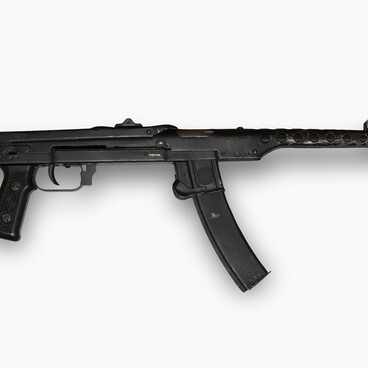The SSh-36 steel helmet was adopted into service by the Workers’ and Peasants’ Red Army and the Workers’ and Peasants’ Red Fleet in 1936. Before that, the army had used the Adrian helmet, or “adrianka”, designed by the French General Louis Auguste Adrian in 1915. The Adrian helmet had been used since World War I and by the 1930s it no longer satisfied the requirements of the new combat conditions.
The new helmet had a dome shape, a prominent rim, and flares on the sides. The shape of the SSh-36 resembled that of the German “Stahlhelm”. The innovations served to protect the soldier’s head from a slashing blow.
The helmet was impenetrable for a sword or a saber, and its dome shape made the blade slip off the surface. The flares and rim deflected the blow. These characteristics were tested personally by the hero of the Russian Civil War and Marshal of the Soviet Union Semyon Budyonny. The small comb on top covered the air inlet. The helmet had a wall thickness of 1.1 mm and a weight of 1.2–1.3 kg.
The helmet was produced in three sizes. The SSh-36 was used by the Red Army during the battle at Lake Khasan (1938), the First Soviet-Finnish War (1939–1940), the Polish Campaign of the Red Army (1939), and the Khalkin-Gol battles (1939) where it received its nickname the “Khalkhingolka”. It was also called the “Khasanka” after the battle at Lake Khasan.
During the Khalkin Gol campaign of 1939, certain disadvantages of the SSh-36 were revealed. The flares created the effect of a sail, hindering the ground forces. The front rim was too large and limited the field of vision. The helmet’s steel was not strong enough for combat conditions, and its protection was inferior compared to similar helmets produced in other countries.
The SSh-36 was the main helmet of the Red Army until 1940 when it was replaced by the SSh-40 which was subsequently used throughout the Great Patriotic War. The SSh-36 from the museum’s collection is painted green and features the silhouette of a red star in front which was typical of such helmets. The helmet has been well-preserved, with slight scuff marks on the surface. The liner is missing.
The new helmet had a dome shape, a prominent rim, and flares on the sides. The shape of the SSh-36 resembled that of the German “Stahlhelm”. The innovations served to protect the soldier’s head from a slashing blow.
The helmet was impenetrable for a sword or a saber, and its dome shape made the blade slip off the surface. The flares and rim deflected the blow. These characteristics were tested personally by the hero of the Russian Civil War and Marshal of the Soviet Union Semyon Budyonny. The small comb on top covered the air inlet. The helmet had a wall thickness of 1.1 mm and a weight of 1.2–1.3 kg.
The helmet was produced in three sizes. The SSh-36 was used by the Red Army during the battle at Lake Khasan (1938), the First Soviet-Finnish War (1939–1940), the Polish Campaign of the Red Army (1939), and the Khalkin-Gol battles (1939) where it received its nickname the “Khalkhingolka”. It was also called the “Khasanka” after the battle at Lake Khasan.
During the Khalkin Gol campaign of 1939, certain disadvantages of the SSh-36 were revealed. The flares created the effect of a sail, hindering the ground forces. The front rim was too large and limited the field of vision. The helmet’s steel was not strong enough for combat conditions, and its protection was inferior compared to similar helmets produced in other countries.
The SSh-36 was the main helmet of the Red Army until 1940 when it was replaced by the SSh-40 which was subsequently used throughout the Great Patriotic War. The SSh-36 from the museum’s collection is painted green and features the silhouette of a red star in front which was typical of such helmets. The helmet has been well-preserved, with slight scuff marks on the surface. The liner is missing.






